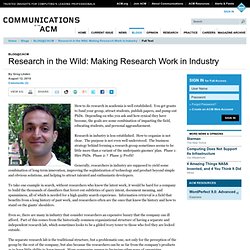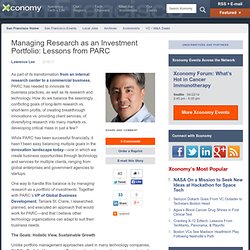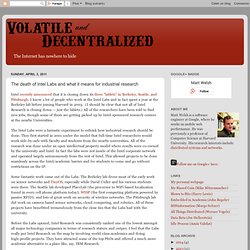

Research in the Wild: Making Research Work in Industry. By Greg Linden August 12, 2010 Comments (3) How to do research in academia is well established.

You get grants to fund your group, attract students, publish papers, and pump out PhDs. Depending on who you ask and how cynical they have become, the goals are some combination of impacting the field, educating students, and personal aggrandizement. Research in industry is less established. How to organize is not clear. Generally, researchers in industry are supposed to yield some combination of long-term innovation, improving the sophistication of technology and product beyond simple and obvious solutions, and helping to attract talented and enthusiastic developers. To take one example in search, without researchers who know the latest work, it would be hard for a company to build the thousands of classifiers that ferret out subtleties of query intent, document meaning, and spamminess, all of which is needed for a high quality search experience. What do you think? Jeremy Pickens. Managing Research as an Investment Portfolio: Lessons from PARC. Lawrence Lee2/16/11 As part of its transformation from an internal research center to a commercial business, PARC has needed to innovate its business practices, as well as its research and technology.

How do we balance the seemingly conflicting goals of long-term research vs. short-term profits, of creating breakthrough innovations vs. providing client services, of diversifying research into many markets vs. developing critical mass in just a few? While PARC has been successful financially, it hasn’t been easy balancing multiple goals in the innovation landscape today—one in which we create business opportunities through technology and services for multiple clients, ranging from global enterprises and government agencies to startups.
One way to handle this balance is by managing research as a portfolio of investments. Together with PARC’s VP of Global Business Development, Tamara St. The Goals: Holistic View, Sustainable Growth Here’s how we did it. Step 1: Define the Asset Classes. Microsoft, Nokia, and RIM's wasted R&D billions. High performance access to file storage Open...and Shut Over the past few decades, governments have decreased their investments in original research, with corporations taking on a greater role.

There are plenty of problems with scientific research funded by private, shareholder-driven companies. Perhaps the worst, however, is that corporate R&D, at least in the technology market, doesn't appear to work. Some of the biggest funders of corporate R&D, including Nokia (R&D equals 14.4 per cent of sales), Microsoft (13.9 per cent) and Research in Motion (6.8 per cent), have virtually nothing to show for it. Nothing that is, except declining market share, compared to their more parsimonious peer: Apple (2.7 per cent). To put this into even sharper contrast, Microsoft spent more in R&D in 2010 than Apple spent in the last decade.
Nor is Google alone in this. No, M&A isn't a panacea for poor performance or product development. Perhaps. It's not that R&D nets the giants nothing at all. The death of Intel Labs and what it means for industrial research. Intel recently announced that it is closing down its three "lablets" in Berkeley, Seattle, and Pittsburgh.

I know a lot of people who work at the Intel Labs and in fact spent a year at the Berkeley lab before joining Harvard in 2003. (I should be clear that not all of Intel Research is closing down -- just the lablets.) All of the researchers have been told to find new jobs, though some of them are getting picked up by Intel-sponsored research centers at the nearby Universities. The Intel Labs were a fantastic experiment to rethink how industrial research should be done. They first started in 2001 under the model that full-time Intel researchers would work side-by-side with faculty and students from the nearby universities.
Some fantastic work came out of the Labs. Before the Labs opened, Intel Research was consistently ranked one of the lowest amongst all major technology companies in terms of research stature and output. I have no idea why Intel decided to close the labs.